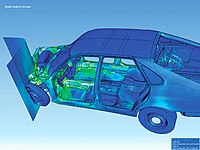
Photo from wikipedia
The residual stresses in the machined workpiece are of great importance due to their influence on the workpiece fatigue life, as well as its dimensional and geometric accuracy. The metal… Click to show full abstract
The residual stresses in the machined workpiece are of great importance due to their influence on the workpiece fatigue life, as well as its dimensional and geometric accuracy. The metal cutting process has always been accompanied by heat generation and severe plastic deformation. This thermo mechanical loading along with the resulted metallurgical changes are the main sources of residual stresses generation at the surface of machined workpiece. The Ultrasonic Assisted Turning (UAT) reduces the temperature in the cutting region and reduces the average machining forces due to the discontinuous contact of the tool and the workpiece. Reducing the intensity of thermo mechanical loading in the UAT process will affect the residual stresses caused by machining. In this paper, the results of thermo mechanical finite element simulation and experimental studies of residual stresses during UAT of AISI 4140 has been studied. The results of this simulation make it possible to determine the effect of vibration and machining parameters (cutting speed and feed rate) on the magnitude and type of surface residual stresses in the workpiece machined by UAT. Finally, the simulation results are compared with experimental measurements of residual stresses using X-ray diffraction technique. Based on the obtained results, the hoop component of the residual stresses in case of UAT became more compressive averagely by about 73.34% compared to the traditional turning; for instance at constant feed of 0.11 mm/rev and cutting speed of 0.261 m/s, for three different vibration amplitudes of 4, 8 and 12 µm, the machining induced residual stresses became more compressive respectively by 53.34%, 73.00% and 100%.
Journal Title: Ultrasonics
Year Published: 2020
Link to full text (if available)
Share on Social Media: Sign Up to like & get
recommendations!